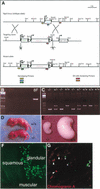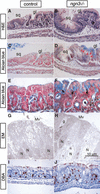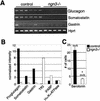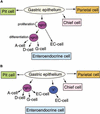Neurogenin 3 is essential for the proper specification of gastric enteroendocrine cells and the maintenance of gastric epithelial cell identity
- PMID: 12080087
- PMCID: PMC186338
- DOI: 10.1101/gad.985002
Neurogenin 3 is essential for the proper specification of gastric enteroendocrine cells and the maintenance of gastric epithelial cell identity
Abstract
The notch signaling pathway is essential for the endocrine cell fate in various tissues including the enteroendocrine system of the gastrointestinal tract. Enteroendocrine cells are one of the four major cell types found in the gastric epithelium of the glandular stomach. To understand the molecular basis of enteroendocrine cell development, we have used gene targeting in mouse embryonic stem cells to derive an EGFP-marked null allele of the bHLH transcription factor, neurogenin 3 (ngn3). In ngn3(-/-) mice, glucagon secreting A-cells, somatostatin secreting D-cells, and gastrin secreting G-cells are absent from the epithelium of the glandular stomach, whereas the number of serotonin-expressing enterochromaffin (EC) cells is decreased dramatically. In addition, ngn3(-/-) mice display intestinal metaplasia of the gastric epithelium. Thus, ngn3 is required for the differentiation of enteroendocrine cells in the stomach and the maintenance of gastric epithelial cell identity.
Figures







Similar articles
-
Neurogenin3 is differentially required for endocrine cell fate specification in the intestinal and gastric epithelium.EMBO J. 2002 Dec 2;21(23):6338-47. doi: 10.1093/emboj/cdf649. EMBO J. 2002. PMID: 12456641 Free PMC article.
-
The bHLH transcription factor ASCL1 promotes differentiation of endocrine cells in the stomach and is regulated by Notch signaling.Am J Physiol Gastrointest Liver Physiol. 2023 Nov 1;325(5):G458-G470. doi: 10.1152/ajpgi.00043.2023. Epub 2023 Sep 12. Am J Physiol Gastrointest Liver Physiol. 2023. PMID: 37698169 Free PMC article.
-
Distinct cellular origins for serotonin-expressing and enterochromaffin-like cells in the gastric corpus.Gastroenterology. 2014 Mar;146(3):754-764.e3. doi: 10.1053/j.gastro.2013.11.048. Epub 2013 Dec 4. Gastroenterology. 2014. PMID: 24316261 Free PMC article.
-
Basic helix-loop-helix transcription factors and enteroendocrine cell differentiation.Diabetes Obes Metab. 2011 Oct;13 Suppl 1(0 1):5-12. doi: 10.1111/j.1463-1326.2011.01438.x. Diabetes Obes Metab. 2011. PMID: 21824251 Free PMC article. Review.
-
[The endocrine cells of the gastrointestinal epithelium and the metabolism of biogenic amines in the gastrointestinal tract (author's transl)].Prog Histochem Cytochem. 1976;8(3):1-128. Prog Histochem Cytochem. 1976. PMID: 136009 Review. German.
Cited by
-
Ascl1b and Neurod1, instead of Neurog3, control pancreatic endocrine cell fate in zebrafish.BMC Biol. 2013 Jul 8;11:78. doi: 10.1186/1741-7007-11-78. BMC Biol. 2013. PMID: 23835295 Free PMC article.
-
Notch signaling differentially regulates the cell fate of early endocrine precursor cells and their maturing descendants in the mouse pancreas and intestine.Dev Biol. 2012 Nov 15;371(2):156-69. doi: 10.1016/j.ydbio.2012.08.023. Epub 2012 Sep 1. Dev Biol. 2012. PMID: 22964416 Free PMC article.
-
Legacy Effect of Foxo1 in Pancreatic Endocrine Progenitors on Adult β-Cell Mass and Function.Diabetes. 2015 Aug;64(8):2868-79. doi: 10.2337/db14-1696. Epub 2015 Mar 17. Diabetes. 2015. PMID: 25784544 Free PMC article.
-
A CRM1-mediated nuclear export signal is essential for cytoplasmic localization of neurogenin 3 in neurons.PLoS One. 2013;8(1):e55237. doi: 10.1371/journal.pone.0055237. Epub 2013 Jan 30. PLoS One. 2013. PMID: 23383123 Free PMC article.
-
FOXO1 inhibition yields functional insulin-producing cells in human gut organoid cultures.Nat Commun. 2014 Jun 30;5:4242. doi: 10.1038/ncomms5242. Nat Commun. 2014. PMID: 24979718 Free PMC article.
References
-
- Artavanis-Tsakonas S, Rand MD, Lake RJ. Notch signaling: Cell fate control and signal integration in development. Science. 1999;284:770–776. - PubMed
-
- Beaulieu JF. Extracellular matrix components and integrins in relationship to human intestinal epithelial cell differentiation. Prog Histochem Cytochem. 1997;31:1–78. - PubMed
-
- Borges M, Linnoila RI, van de Velde HJ, Chen H, Nelkin BD, Mabry M, Baylin SB, Ball DW. An achaete-scute homologue essential for neuroendocrine differentiation in the lung. Nature. 1997;386:852–855. - PubMed
-
- Duncan SA, Nagy A, Chan W. Murine gastrulation requires HNF-4 regulated gene expression in the visceral endoderm: Tetraploid rescue of Hnf-4(−/−) embryos. Development. 1997;124:279–287. - PubMed
-
- Falk P, Roth KA, Gordon JI. Lectins are sensitive tools for defining the differentiation programs of mouse gut epithelial cell lineages. Am J Physiol. 1994;266:G987–G1003. - PubMed
Publication types
MeSH terms
Substances
Grants and funding
LinkOut - more resources
Full Text Sources
Other Literature Sources
Molecular Biology Databases
